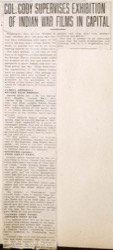Title: Col. Cody Supervises Exhibition of Indian War Films in Capital
More metadata
COL. CODY SUPERVISES EXHIBITON OF INDIAN WAR FILMS IN CAPITAL
Washington, Feb. 17 — Col. William F. Cody (Buffalo Bill) has been here several days hobnobbing with many of his retired old-time army officer friends for whom he scouted and led in the fierce fighting days of the frontier Indian wars.
The main purpose of his visit at this time is to supervise private exhibitions of the frontier motion pictures taken under the auspices of the war and interior departments in South Dakota and other far West points, last fall. These films show the reproduction of the famous Indian wars of pioneer days. The settings for the pictures have been accepted as historically correct and the films are to be preserved by the government in the archives of the Indian and war departments for the education of future generations.
FAMOUS GENERALS BECOME FILM HEROES.
General Miles, Gen. J. M. Lee, General M. D. Baldwin, General Maus, Gen. Charles King, Colonel Sickles, Colonel Cody and other notable United States army men who participated in the historical Indian battles of the earlier days in the Rocky Mountain regions were the principals in the recently taken moving pictures.
"These pictures depict, among other battles, that of Summit Springs in 1869," Colonel Cody explained to a party of newspaper writers who are to witness a private exhibition of the pictures today. "Gen. C. A. Carr was in command of the government troops and I had the honor to be his chief of scouts.
"It was General Carr," he recalled, "who ridded Nebraska, Kansas and Colorado of the desperate 'Dog Soldier Renegades.' All three of the then territorial legislatures passed resolutions of thanks to General Carr and his command.
RELIEVED CROOKS FROM GREAT PERIL.
Another battle reproduced for the picture films in which Colonel Cody was an active participant was that of "War Bonnet Creek," under General Wesley Merrit and General Carr. They relieved General Crook and his command from great peril, and the motion photographs taken last fall are pronounced to be historically correct portrayals of that famous and perilous rescue.
Other films show the final Indian campaigns and the declaration of perpetual peace after the Ghost Dance war in 1890-91.
"My mission in Washington," says Colonel Cody, "was to deliver these pictures to the government. These particular films are to be filed away in the archives of the war and interior departments and will keep alive in a vivid way the early history recorded in the paving of the way for the settlement of the great West by the government."
COLONEL CODY LOOKS YOUNGER THAN EVER.
The famous scout will be the star attraction this coming season in the Sells-Floto circus and Buffalo Bill (himself).
The Washington Post, in the course of a lengthy article concerning Colonel Cody's presence in Washington, says that:
"Colonel Cody is in fine physical condition and looks younger than he did the last time he appeared in Washington with his show. He is still that picturesque character, full of snap and ginger, straight as an arrow, with a ruddy complexion and long, gray hair, military mustache and goatee."
This was in answer to an unfounded rumor that the noted frontiersman and showman was ill in a Washington hospital.
Title: Col. Cody Supervises Exhibition of Indian War Films in Capital
Source: McCracken Research Library, Buffalo Bill Center of the West, William F. "Buffalo Bill" Cody Collection, MS6, OS Box 50, page 6
Topics: Buffalo Bill on Film
Keywords: Sells-Floto Circus Washington Post Company
People: Miles, Nelson Appleton, 1839-1925 Lee, Jesse M. Baldwin, Frank Dwight, 1842-1923 Maus, Marion P. (Marion Perry), 1850-1930 King, Charles, 1844-1933 Sickel, Horatio Gates, Jr. Carr, E. A. (Eugene Asa), 1830-1910 Merritt, Wesley, 1834-1910 Crook, George, 1829-1890
Places: Washington (D.C.) South Dakota Summit Springs (Colo.) Nebraska Kansas Colorado Warbonnet Creek (Neb.)
Editorial Statement | Conditions of Use
TEI encoded XML: View wfc.nsp11323.xml
Back to top
